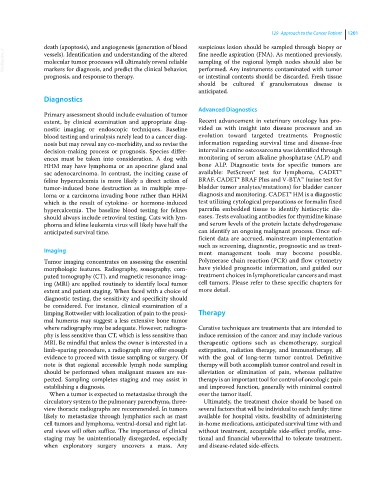Page 1263 - Clinical Small Animal Internal Medicine
P. 1263
129 Approach to the Cancer Patient 1201
death (apoptosis), and angiogenesis (generation of blood suspicious lesion should be sampled through biopsy or
VetBooks.ir vessels). Identification and understanding of the altered fine needle aspiration (FNA). As mentioned previously,
sampling of the regional lymph nodes should also be
molecular tumor processes will ultimately reveal reliable
markers for diagnosis, and predict the clinical behavior,
or intestinal contents should be discarded. Fresh tissue
prognosis, and response to therapy. performed. Any instruments contaminated with tumor
should be cultured if granulomatous disease is
anticipated.
Diagnostics
Advanced Diagnostics
Primary assessment should include evaluation of tumor
extent, by clinical examination and appropriate diag- Recent advancement in veterinary oncology has pro-
nostic imaging or endoscopic techniques. Baseline vided us with insight into disease processes and an
blood testing and urinalysis rarely lead to a cancer diag- evolution toward targeted treatments. Prognostic
nosis but may reveal any co‐morbidity, and so revise the information regarding survival time and disease‐free
decision‐making process or prognosis. Species differ- interval in canine osteosarcoma was identified through
ences must be taken into consideration. A dog with monitoring of serum alkaline phosphatase (ALP) and
HHM may have lymphoma or an apocrine gland anal bone ALP. Diagnostic tests for specific tumors are
sac adenocarcinoma. In contrast, the inciting cause of available: PetScreen® test for lymphoma, CADET®
feline hypercalcemia is more likely a direct action of BRAF, CADET® BRAF Plus and V‐BTA™ (urine test for
tumor‐induced bone destruction as in multiple mye- bladder tumor analytes/mutations) for bladder cancer
loma or a carcinoma invading bone rather than HHM diagnosis and monitoring. CADET® HM is a diagnostic
which is the result of cytokine‐ or hormone‐induced test utilizing cytological preparations or formalin fixed
hypercalcemia. The baseline blood testing for felines parrafin embedded tissue to identify histiocytic dis-
should always include retroviral testing. Cats with lym- eases. Tests evaluating antibodies for thymidine kinase
phoma and feline leukemia virus will likely have half the and serum levels of the protein lactate dehydrogenase
anticipated survival time. can identify an ongoing malignant process. Once suf-
ficient data are accrued, mainstream implementation
such as screening, diagnostic, prognostic and as treat-
Imaging ment management tools may become possible.
Tumor imaging concentrates on assessing the essential Polymerase chain reaction (PCR) and flow cytometry
morphologic features. Radiography, sonography, com- have yielded prognostic information, and guided our
puted tomography (CT), and magnetic resonance imag- treatment choices in lymphoreticular cancers and mast
ing (MRI) are applied routinely to identify local tumor cell tumors. Please refer to these specific chapters for
extent and patient staging. When faced with a choice of more detail.
diagnostic testing, the sensitivity and specificity should
be considered. For instance, clinical examination of a
limping Rottweiler with localization of pain to the proxi- Therapy
mal humerus may suggest a less extensive bone tumor
where radiography may be adequate. However, radiogra- Curative techniques are treatments that are intended to
phy is less sensitive than CT, which is less sensitive than induce remission of the cancer and may include various
MRI. Be mindful that unless the owner is interested in a therapeutic options such as chemotherapy, surgical
limb‐sparing procedure, a radiograph may offer enough extirpation, radiation therapy, and immunotherapy, all
evidence to proceed with tissue sampling or surgery. Of with the goal of long‐term tumor control. Definitive
note is that regional accessible lymph node sampling therapy will both accomplish tumor control and result in
should be performed when malignant masses are sus- alleviation or elimination of pain, whereas palliative
pected. Sampling completes staging and may assist in therapy is an important tool for control of oncologic pain
establishing a diagnosis. and improved function, generally with minimal control
When a tumor is expected to metastasize through the over the tumor itself.
circulatory system to the pulmonary parenchyma, three‐ Ultimately, the treatment choice should be based on
view thoracic radiographs are recommended. In tumors several factors that will be individual to each family: time
likely to metastasize through lymphatics such as mast available for hospital visits, feasibility of administering
cell tumors and lymphoma, ventral‐dorsal and right lat- in‐home medications, anticipated survival time with and
eral views will often suffice. The importance of clinical without treatment, acceptable side‐effect profile, emo-
staging may be unintentionally disregarded, especially tional and financial wherewithal to tolerate treatment,
when exploratory surgery uncovers a mass. Any and disease‐related side‐effects.

